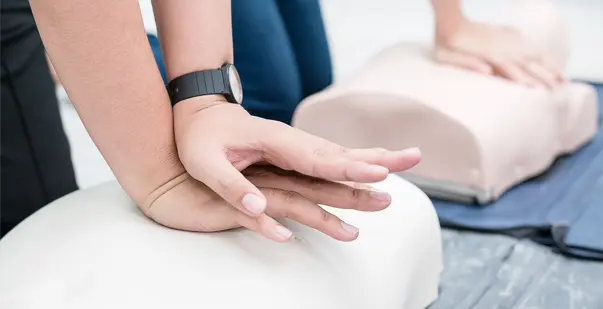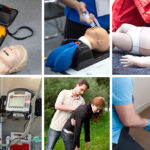CPR or cardiopulmonary resuscitation, is one of the most well-known medical procedures in the world. With a combination of 30 chest compressions and necessary and mandated two rescue breaths, a trained bystander can intervene in the event of a life-threatening medical emergency and drastically increase the victim’s chance of survival. CPR can be the difference between life and death in emergency medical situations like cardiac arrest, stroke, smoke inhalation, near-drowning, or electrocution. The bystander also checks tbol cycle in with the patient to check if the person is unconscious before performing CPR and helping them revive their heartbeats on time.
In this blog, we’re taking a closer look at CPR and breaking down the 7 fundamental steps of this important, life-saving procedure. The American CPR Care Association is dedicated to providing high-quality and accessible CPR training to as many people as possible. This is why we offer 100 percent online CPR certification and recertification courses.
With just a few clicks, you can begin learning the essential steps of CPR or cardiopulmonary resuscitation and other life-saving medical procedures, like First Aid or how to use an automated external defibrillator (AED). By starting CPR training classes, you’ll have the knowledge, skills, and confidence to respond in the event of an emergency.

Why is CPR so Important?
CPR, quite simply, can save lives. Every year, hundreds of thousands of people experience cardiac arrest, and roughly 475,000 American lives are lost to this medical condition. Because so many of these episodes occur outside of a hospital, a majority prove to be fatal. In fact, according to the Center for Disease Control and Prevention (CDC), 70 to 90 percent of “out of the hospital cardiac arrests” (OHCA) are fatal.
After calling 911, it can take some time for medical personnel to arrive on the scene. Following a cardiac arrest episode, however, every second matters. This is why the actions of bystanders may prove to be the difference between life and death.
What are the 7 Steps of CPR?
CPR is a relatively straightforward medical procedure that anyone can learn. Even those outside of the medical field can benefit from learning the critical CPR steps. With proper training, anyone can gain the skills and confidence to save a life.
It’s important to note that the following steps are for performing CPR on an adult. While administering CPR to a child or infant is similar, there are significant differences between the techniques. It’s essential to take comprehensive CPR training courses that cover the distinctions between adult, child, and infant CPR.
- STEP 1: CALL 911
Before beginning the steps of CPR to get blood flowing, call 911 or ask a bystander to call the emergency medical team. CPR is intended to keep a victim stable until medical help arrives—it doesn’t cure cardiac arrest or any other medical condition. - STEP 2: ASSESS THE SCENE OF THE EMERGENCY
After you call 911, you should assess the scene. You don’t want to waste any time; however, you also don’t want to place yourself or others in additional danger. Assess the scene of the emergency and the condition of the victim to make sure that CPR will be the most effective procedure. Watching the chest fall will indicate you if victim is still unresponsive or is unable to regularly breathe because if their chest does not fall, you should immediately begin CPR. - STEP 3: OPEN THE VICTIM’S AIRWAY
To begin CPR, you need to position the victim. Make sure that they are lying flat on their back; however, be careful about moving their body if you think they experienced a head or neck injury. With the victim lying flat on their back, tilt their head back and slightly lift their jaw. You should also check to see if there is an object obstructing their airway. - STEP 4: CHECK FOR BREATHING
After opening the airway, you should check to see if the victim is breathing. Lower your ear over their mouth and listen for about ten seconds. If you don’t hear or see any signs of breathing, immediately begin CPR. If the victim is occasionally gasping for air, you should still begin CPR. If the victim is unresponsive but breathing at a normal pace, you do not need to perform CPR; however, you should still check their breathing regularly until paramedics arrive. - STEP 5: 30 CHEST COMPRESSIONS
Now, you can begin the steps of CPR. Place one hand over the other to start chest compressions and interlock your fingers. Place your hands on the center of the chest, just below the breastbone, straighten your arms, apply your whole body weight, and press firmly at least two inches deep with compressions at a rate of 100 to 120 per minute. Allow the chest to rise between compressions. - STEP 6: 2 RESCUE BREATHS
Following chest compressions, you should begin giving rescue breaths. Ensure the airway is still open by tilting the head back and slightly lifting the chin. Also, ensure to shut the nose shut and place your mouth afterward for rescue breaths. Make sure that their airway is open, and blow into the victim’s mouth. Give two rescue breaths and watch their chest to see if it rises to ensure that their airway is open. If not, you may need to reposition the airway. Make sure to use your body weight not just your arms.
However, it should be noted that many experts assert that rescue breaths may not be necessary for performing effective CPR. Hands-only CPR (where you only provide chest compressions) is an effective method of CPR and can be just as helpful as CPR with rescue breaths. Learn more about hands-on CPR here. - STEP 7: REPEAT THE CYCLE
Continue the cycle of chest compressions and rescue breaths until professional medical assistance arrives. If someone else nearby is also trained in CPR, you can take turns to ensure that you don’t become worn out. Keep performing CPR until medical assistance hits the scene.

How is an AED Helpful in Cardiac Arrest Situations?
If one is nearby, you should also use an AED (automated external defibrillator) on a cardiac arrest victim. These small medical devices are designed to reset the victim’s heartbeat to correct an irregular rhythm (arrhythmia). These devices are small and easy to use and can be found in many public places, such as hospitals, schools, and government buildings. When you receive your CPR certification, many programs also include training on how to safely and effectively use an AED on a cardiac arrest victim.
Benefits of becoming online CPR-Certified
If you’re interested in becoming CPR certified, we highly recommend looking into online CPR certification classes. Compared to the traditional model, online CPR classes are convenient, fast, and tend to be more cost-effective. Online classes are designed to fit your needs and schedule. You can start and stop your lessons at any moment and learn CPR and other emergency medical procedures at your own pace. For those with a hectic schedule, online CPR training is ideal.
Conclusion
We all hope to never find ourselves in the midst of a life-threatening medical emergency. However, if the moment does arise, don’t you want to be prepared? This is why earning your tren pills for sale certification is so important. By earning your CPR certification or recertification, you’ll learn the 7 steps of CPR, how to use an AED, and how to respond effectively in the event of an emergency such where victim’s heart stops beating. Even if you aren’t in the medical field, CPR training is important.
To train as many individuals as possible, American CPRCare Association is proud to offer 100 percent online CPR certification classes. We also offer CPR/AED courses that train you how to properly use an automated external defibrillator (AED). Learning these valuable medical skills has simply never been this easy, convenient, or affordable.
For more information on our CPR certification, CPR/AED certification, or other medical certification courses that we offer visit https://cprcare.com or reach out via our email or phone at [email protected] or 1-888-808-9109. We look forward to helping you gain the skills, knowledge, and confidence to save lives.








